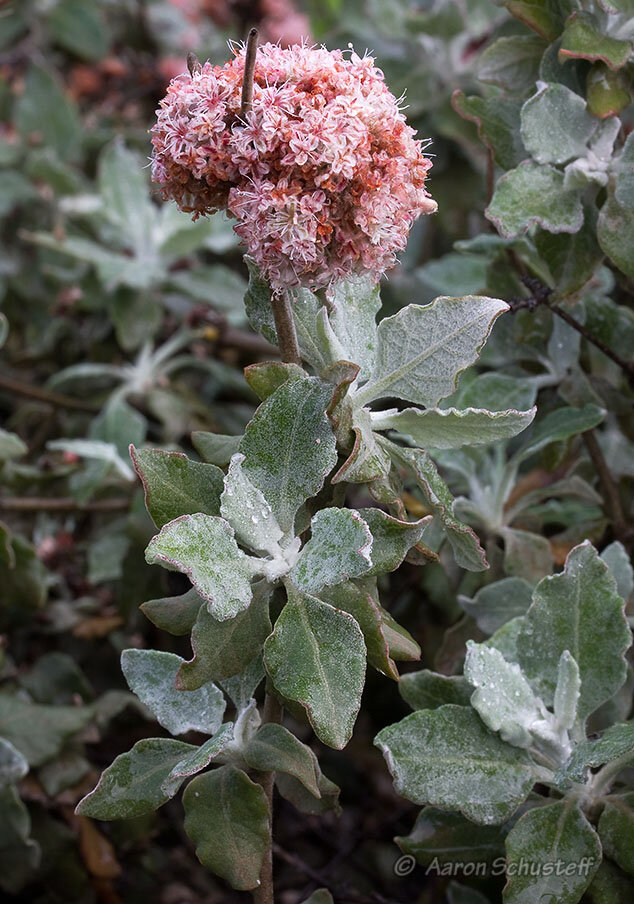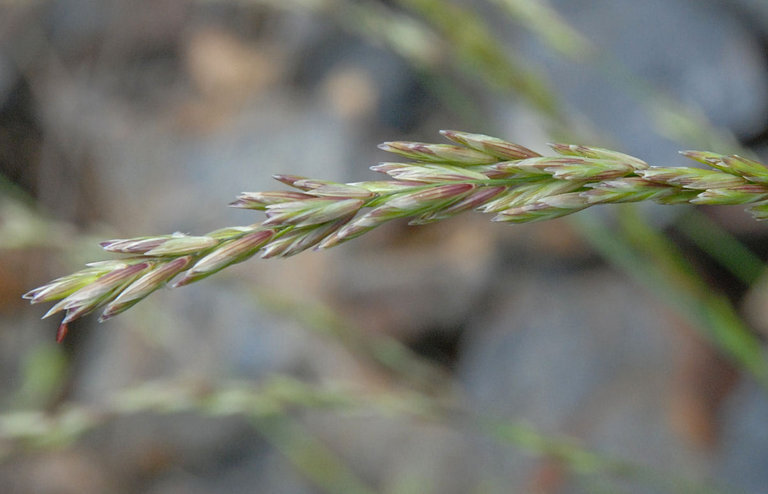
Western Ragweed
Ambrosia psilostachya
Western Ragweed had a number of medicinal uses among several different Native American groups. Additionally, the plant is thought to be host to over 20 butterfly and moth species.

California Brittlebush
Encelia californica
California brittlebush is an important host plant for the Bay checkerspot butterfly, whose survival is threatened. Its relationship with this plant is key to its endurance as a species. As for human use, the Kumeyaay people notably used this plant to treat toothaches and chest pains.

California Aster
Corethrogyne filaginifolia
California aster has summer flowers that make showy cheerful displays along roadsides of much of Coastal Southern California. Great for a woodland shade garden or full sun flower garden along the coast. This plant is well liked by our native moths and butterflies as a nectar source.

California Sagebrush
Artemisia californica
A highly aromatic shrub native to California, this sagebrush is very drought tolerant. Termed “cowboy cologne”, the aromatic compounds of the sagebrush evaporate to help cool the plant in the harsh summer months.

California Mugwort
Artemisia douglasiana
An important medicinal plant for Native Californians, mugwort is an under-appreciated garden perennial. When rubbed on the skin, the leaves have a natural moisturizing effect and are said to counteract the oils of poison oak if applied immediately, which is handy since they are often found growing near one another. Additionally, this plant is useful for restoration and erosion control.

California Brickellbush
Brickellia californica
One of the best smelling California native plants. Although not particularly beautiful, it has an amazing fragrance that comes out in the summer months when it is in bloom, and the fragrance can carry a considerable distance.

California Brome Grass
Bromus carinatus
In the garden California Brome has a reputation for being short-lived but the plant readily re-seeds. It competes well with non-native weeds, and its sod-building root system makes it useful for erosion control.

Giant Wild Rye
A prominent tall native grass that usually does not make its way into traditional residential landscapes but can be used very effectively in a native or natural garden.

California Goldenbush
Ericameria ericoides
Part of the sunflower family, this bushy aster shrub bears radiant yellow daisy flowers on long stems.

Coastal Buckwheat
Eriogonum cinereum
This shrub is endemic to the coastline of California, where it grows on beaches and bluffs and in coastal scrub and chaparral. It’s a great addition to the butterfly garden where it is a nectar source for the Gray Hairstreak, the Common Buckeye and the Mournful Duskywing.

Coastal Goldenbush
Isocoma menziesi
Goldenbush, a member of the Sunflower family, is native to central and southern California, where it grows in coastal and inland coastal sage scrub habitats, particularly in sandy soils. Because of its very long bloom time it is a good choice for coastal gardens.

Seacliff Buckwheat
Eriogonum parvifolium
Sea Cliff Buckwheat is a great plant for coastal and seaside landscapes. It prefers full sun in its natural range, and does best in sandy soils, or on rocky slopes or cliffs. Easy, fast growing, very drought-tolerant and beautiful. It looks great hanging down over cliffs, slopes or walls, and is an important butterfly plant in the seaside and coastal plant communities.

Toyon
Heteromeles arbutifolia
Also known as California Holly, Toyon bears bright red fruit. Folklore posits that the European settlers of LA County saw the abundant Holly-like trees and were inspired to name “Hollywood” as such. The berries were used abundantly by Native Americans, often mashed into water to make a drink. Toyon can be planted near houses since they are fire retardant when given enough moisture.

Bladderpod
Isomeris arborea
Bladderpod is an interesting desert shrub covered with showy yellow flowers. It is an insect magnet, often covered with pollinators of all kinds, although its odor has been described as "foul". The seeds can spread long distances over water due to their unique buoyancy attributed to the “bladder-like” structure.

California Black Walnut
Juglans californica
This tree is endemic to California, meaning it can’t be found anywhere else in the world. Unfortunately, it is now endangered in large parts of southern CA due to increasing development. It is a good addition to gardens in naturally moist areas. However, It must be noted that toxins in walnut seeds will typically prevent other plants from growing under this tree, so don't try to plant understory plants too near.

Heart Leaf Penstemon
Keckiella cordifolia
Great for bird gardens, this sprawling shrub can reach a height of 6 to 8 feet. Often found clambering over other shrubs or trailing over banks, it bears heart-shaped leaves of glossy green resembling those of the garden fuchsia. Its flowers are large and brilliant orange scarlet.

Laurel Sumac
Malosma laurina
Sometimes referred to as the “taco plant”, this sumac’s taco-shaped leaves track the sun. When it’s too bright, they fold in half but when they need a little extra light they open wide! Large clusters of tiny white flowers occur at the ends of its branches in late spring and early summer.

California Melic
Melica imperfecta
California melic grass is one of the smaller native bunchgrasses, with an interesting inflorescence of purple-banded green spikelets. As the seed ripens, the stalks turn silver and are very distinctive, resembling a cereal. Large seeds slide easily off the flower stalks.

Scarlet Monkey Flower
Mimulus cardinalis
Scarlet Monkey Flower is an aggressive seeder that is great for use in revegetation or large gardens (or for those people that kill everything else). It's serpentine tolerant and its flowers, which are very showy, attract and support Hummingbirds.

Deer Grass
Muhlenbergia rigens
Deer grass grows on banks of seasonal creeks, along roads or in gullies where the runoff forms in winter. You can plant it in dry stream beds, along driveways or along the street edge to slow runoff. It was also commonly used for making baskets by native americans.

California Sycamore
Platanus racemosa
California Sycamore is a picturesque, fast growing and long lived deciduous tree that can grow to as tall as 100 feet. The wide-spreading branches are often twisted or leaning with gray-brown bark peeling off to expose the white wood underneath in a mottled pattern. It tolerates the heat and the smoggy conditions of our urban environments well.

Coast Live Oak
Quercus agrifolia
The Coast Live Oak is one of the only California native oaks that actually thrives in the coastal environment, although it is rare on the immediate shore; it enjoys the mild winter and summer climate afforded by ocean proximity, and it is somewhat tolerant of aerosol-borne sea salt. The coastal fog supplies relief from the rainless California summer heat.

Lemonade Berry
Rhus integrifolia
The native people of California ate the fruits of the lemonade berry raw. They would also soak the berries in water to make beverages, and grind the dried berries into flour for a mush or to add to soup. Lemonade berry can be planted in your garden and likes full sun to part shade and average soil. However, topical exposure to the plant oils may cause a rash (a potential hint to their poison oak cousin).

Wild Rose
Rosa californica
Wild Rose is an evergreen branching thorny bush with cheery pink flowers that most commonly bloom in summer months. The fruit or rose hip is high in vitamin C and can be imbibed as tea or made into jam. Native Americans and early settlers used the roots for various medicinal purposes.

Pacific Blackberry
Rubus ursinus
In southern California this blackberry doesn't always bear fruit. It appears like it does only when conditions are right: in cool, moist, years. The plants harbor beneficial insects as well. However, growing Pacific Blackberry requires some thought and care because its numerous prickles can make harvesting the fruits, weeding, pruning and other maintenance activities unpleasant.

























